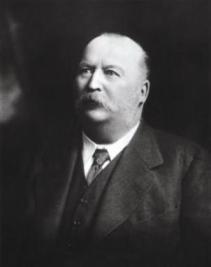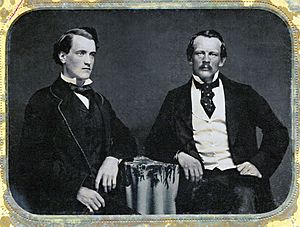William Knox D'Arcy facts for kids
Quick facts for kids
William Knox D'Arcy
|
|
|---|---|
 |
|
| Born | 11 October 1849 |
| Died | 1 May 1917 (aged 67) Middlesex, England
|
| Nationality | English, British |
| Education | Westminster School |
| Spouse(s) | Elena Birkbeck (m. 1872) |
William Knox D'Arcy (born October 11, 1849 – died May 1, 1917) was a British businessman. He is known for being one of the main people who started the oil and chemical industry in Iran (then called Persia). In 1901, he signed an important agreement called the D’Arcy Concession. This agreement allowed him to look for, get, and sell oil and natural gas in Persia.
Contents
Early Life and Moving to Australia
William Knox D'Arcy was born in Newton Abbot, a town in Devon, England. His father was a lawyer. William went to Westminster School until 1866. That year, his family moved to Australia because his father had financial problems. They settled in a place called Rockhampton in Queensland.
William continued his studies and decided to become a lawyer, just like his father. He did well in his father's business. Soon, he started to invest his money, first by buying and selling land. In 1872, he married Elena Birkbeck in Australia. Elena was born in Mexico. Her father was a mining engineer from the United States.
Mining Success in Australia
In 1882, William D'Arcy became a partner in a business group. This group included Walter Russell Hall and Thomas Skarratt Hall. They joined with the Morgan brothers to open a gold mine. This mine was on Ironstone Mountain, which was later renamed Mount Morgan. It was about 24 miles south of Rockhampton. The mine at Mount Morgan Mine had a very large amount of gold.
In 1886, their business group became a company called the Mount Morgan Gold Mining Company. D'Arcy was a director and owned the most shares in the company. At one point, his shares were worth a huge amount of money. The company also worked a rich gold mine in New Zealand.
Searching for Oil in Persia
In 1889, William D'Arcy had become very wealthy. He and his family moved back to England. He bought large homes and lived a fancy life. His first wife, Elena, passed away in 1897. In 1899, he married Nina Boucicault. They often hosted big parties and entertained many guests. William also loved horse-racing.
In 1900, D'Arcy agreed to pay for a search for oil and other minerals in Iran, which was then known as Persia. Negotiations started in 1901 with the ruler of Persia, Mozaffar ad-Din Shah Qajar. D'Arcy offered £20,000 for a 60-year agreement to look for oil. This agreement, called the D'Arcy concession, was signed in May 1901. It gave D'Arcy the rights to oil in almost the entire country. In return, the Persian government would get 16% of the oil company's yearly profits. This agreement was very important for the British government. They became very interested in Iran's stability because of its huge oil reserves.
A team of drillers, led by George B. Reynolds, began drilling for oil in late 1902. By 1904, D'Arcy had spent a lot of money. He was running out of funds. So, in 1905, a new company was formed called the Concession Syndicate. The Burmah Oil Company Ltd. became a major investor, and D'Arcy's project became part of it. Operations then moved to a new area in 1906.
Drilling continued in southern Persia until 1907. Then, the search moved to Masjed Soleyman. Drilling started there in January 1908. By April, they still had not found oil. The project was close to failing, and D'Arcy was almost out of money. He and Burmah Oil decided to stop looking for oil in Iran. In early May 1908, they sent a message to Reynolds telling him to stop work and send everyone home.
However, Reynolds waited a bit longer. Then, something amazing happened! On May 26, 1908, they struck oil at 1,180 feet deep. This was a huge success!
In 1909, D'Arcy became a director of a new company called the Anglo-Persian Oil Company (APOC). This company later became British Petroleum (BP). By 1911, APOC had built a pipeline from the oil find to a refinery in Abadan.
Later Life and Legacy
Later in his life, William D'Arcy lived at Stanmore Hall in Middlesex, England. He had the house made bigger and decorated it with famous artworks. He owned beautiful tapestries and paintings by well-known artists.
William Knox D'Arcy passed away on May 1, 1917, when he was 67 years old.
In 2012, D'Arcy was honored and added to the Queensland Business Leaders Hall of Fame. This recognized his important contributions to business and industry.
See also
 In Spanish: William Knox D'Arcy para niños
In Spanish: William Knox D'Arcy para niños


